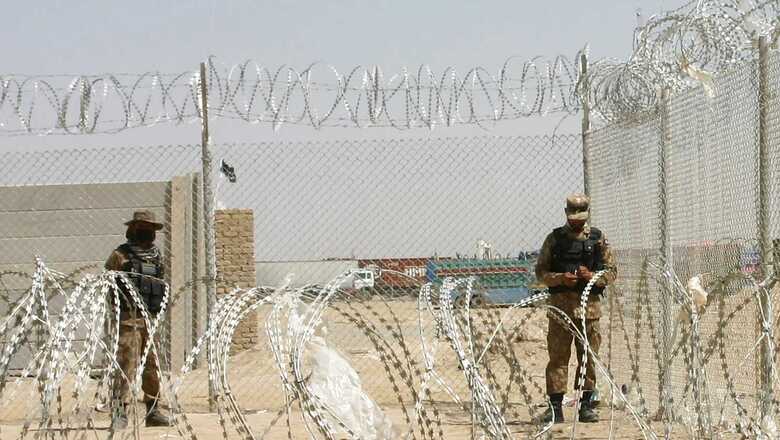
views
For some weeks now, there has been a spate of incidents along the Afghanistan-Pakistan frontier involving the Afghan Taliban and their principal backers — the Pakistan Army. The Taliban have torn down the border fence in a number of areas; they have prevented Pakistan Army from erecting the fence in other areas; there have been some clashes and incidents of cross-border exchange of fire, including of artillery. Further, warnings have been issued to Pakistani soldiers to back down or else face the Taliban onslaught; Pakistan Army soldiers have been mocked, lampooned and threatened and told that soon the Taliban will be coming for them; there have been reports of arrests of Pakistani security force personnel and also of some incursions by Taliban militia men; strong statements by Taliban officials have raised questions about not just the fencing but also about Durand line.
But increasingly, analysts are starting to look askance at the strategic calculus of Pakistan’s security establishment which saw the Taliban as its best bet in securing its western flank. Questions are being raised on whether a Taliban dispensation in Afghanistan will become a factor of stability, or will they pose an existential threat to the Pakistani state and society? There is a palpable sense of disquiet in Pakistan over how the situation along the Af-Pak border is unfolding. There are apprehensions that if the situation deteriorates, it could be exploited by elements and forces inimical to Pakistan. Things could very quickly spiral out of control, putting paid to Pakistan’s grand strategic plans to make Afghanistan a lynchpin of its geo-economic dreams.
The pliant Pakistani media has mostly been reluctant to report and raise the border incidents. Much of the news about what is happening on the Af-Pak border is coming through social media. Not surprisingly, Pakistani officials who have invested so much in the Taliban, and had with unrestrained glee celebrated the defeat of the US and victory of the Taliban, have played down these incidents. The Pakistan Army spokesman while reiterating that the border fence will be erected has called the border incidents ‘localised problems’. He said Pakistan has very good relations with the Taliban dispensation in Afghanistan and expressed confidence that any misunderstanding would be resolved between the two sides.
Localised Problems?
So, just how serious is the Taliban-Pakistan spat? Is it a sign of a cleavage that exists between Afghanistan and Pakistan and between the Taliban and Pakistan and will only grow into a chasm? Or is it just one of those things that will remain an irritant between Kabul and Islamabad but will not escalate into something bigger than that?
At the current juncture, there is clear incongruity between how Pakistan is approaching the incidents on the border and how the Taliban are dealing with the same issues. The Pakistani soft-peddling in the face of Taliban irredentism is not unexpected. Joining issue over these ‘localised problems’ wouldn’t really serve any purpose. In fact, escalating matters either through statements or some kind of kinetic pushback could boomerang and lead to a breach into which other players could enter.
Pakistan’s larger strategic game plan requires ignoring some pin-pricks that are inherent in the situation. Such clashes and problems occurred even in the 1990s during Taliban 1.0. But they were never allowed to impact the larger relationship between Pakistan and the Taliban regime. Pakistan continued backing, even funding, Mullah Omar despite the fact that the Taliban didn’t accept Durand Line as the border, or stopped giving refuge to Pakistani Islamist terrorists. To the extent Pakistan can manage it, the same dynamic will play out with Taliban 2.0. There will be voices and noises from inside Pakistan demanding action, but the military establishment will ignore them, if it can’t entirely silence them.
Bigger Points of Friction
The truculence of the Taliban is also not surprising. Despite Pakistan going all out to get the world to recognise and engage with the Emirate and give it economic and humanitarian assistance, the Taliban haven’t relented on both the fencing as well as the Durand Line. Far from it, senior Taliban officials have made statements that would be jarring for any Pakistani. Some of these statements reflect what many among the Taliban think of Pakistan. It is a known fact that there are clear divisions within the Taliban ranks between those beholden to Pakistan — Haqqani Network — and those who have an antipathy for Pakistan — the Kandharis. While the latter have their scores to settle, the former have to dispel the impression that they are Pakistani puppets. For their own reasons, both sides are bound to raise questions over the fencing and the border.
There are also some other factors at play. Many Afghans, regardless of whether they are anti- or pro-Pakistan, are not ready to accept the Durand Line as the border between the two countries. There is almost a sort of consensus cutting across ethnic, tribal, regional, ideological, political lines on this issue. Any Afghan who appears amenable to compromising on the Durand line issue will immediately be labelled a lackey of Pakistan. Then, there is the issue of the fencing obstructing unfettered movement of people (refugees) and goods (smuggling) across the border. While the Pakistanis would want to seal such movement into its borders, the Afghans could want to open up these routes which are major revenue earners and money spinners.
The border issue will therefore remain outstanding and is unlikely to be settled to Pakistan’s satisfaction anytime soon. It is however unlikely to become a flashpoint that could lead to conflict between the two countries, at least not in the foreseeable future. Both sides will make routine noises but neither side will unilaterally try to force a change in the status quo. Nor will they allow this issue to impact their broader relationship.
More than the issue of fencing and border, it is the Tehrik-e-Taliban Pakistan (TTP) factor that could poison the bilateral relationship. For now, the Pakistanis are putting pressure on the Taliban to rein in the TTP and not allow it to operate from Afghan soil. But the Pakistanis realise that the Taliban are unlikely to take any action against the Pakistani Taliban. As long as the TTP attacks are limited to the trans-Indus region – Khyber Pakhtunkhwa and Balochistan – the Pakistanis might be even willing to live with this menace. But if the scale and scope of the TTP attacks increase, and their area of operation crosses the Indus into Punjab (which is Pakistan), then it will be a deal breaker. At that stage Pakistan might even be forced to take kinetic action against the TTP inside Afghanistan. Such an action could put both countries on the escalation spiral because the Taliban will be forced to retaliate.
For now at least, not too much should be read into the spats along the Durand Line. In a way, these border incidents serve as an alibi for both Pakistan and Taliban: the former can use these to spin the yarn that the Taliban aren’t their proxies; the latter can use them to show their own people that their strings aren’t being pulled from Rawalpindi. Because both sides need each other in the short- to medium-term, they will paper over some of these irritants, and learn to ignore or downplay those they can’t.
And yet, because both sides have their own ambitions and agendas that aren’t entirely congruous, going forward there are going to be some serious points of friction – ideological, terrorism, ethnic, economic, resources etc. These factors, when they come into play, will be more potent than either the fence or the Durand Line issue, both of which will then dovetail with them to create an explosive cocktail. Rather than wasting time over the shadow boxing that is currently happening, the time to jump into the fray will be when the real break comes and the fighting starts.
Sushant Sareen is Senior Fellow, Observer Research Foundation. The views expressed in this article are those of the author and do not represent the stand of this publication.
Read all the Latest Opinions here



















Comments
0 comment